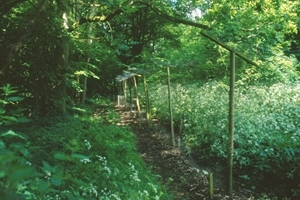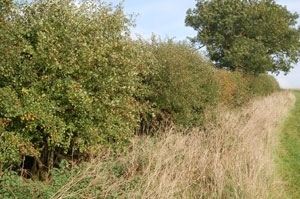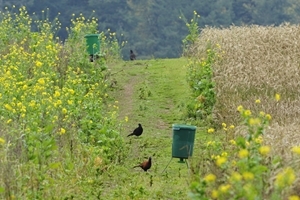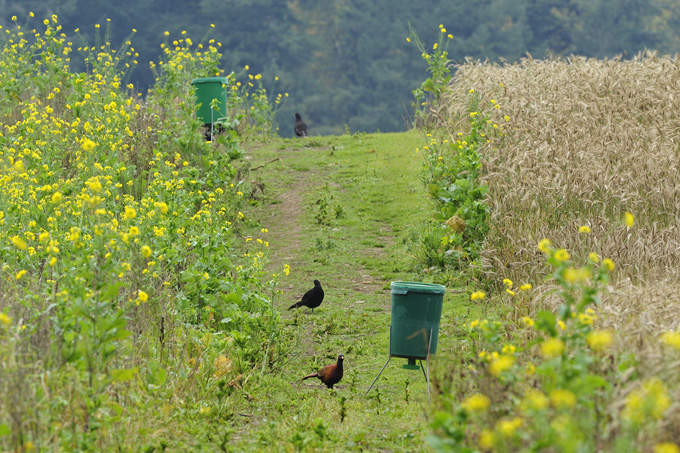Woods used for shooting tend to have greater wildlife biodiversity than unmanaged woods because they have more shrubs, better surrounding hedges and more glades and rides. However, concentrations of pheasants and red-legged partridges can reduce biodiversity in and sometimes around release pen sites. Sustainable gamebird management is based on minimising biodiversity loss and balancing it with improvements elsewhere. These guidelines are based on findings from several GWCT studies undertaken over the last five years.
Released gamebirds underpin most lowland game shooting in Britain. Over the last 10 years, some people have expressed concerns over the scale of this releasing and particularly its effect on lowland habitats. In response, we undertook new research to measure the effects of released pheasants and red-legged partridges on other wildlife and wildlife habitats. Our aims were to:
- Provide a science-based approach to quantifying any negative effects of gamebird releasing and to develop solutions where these effects occur.
- Identify and quantify any benefits to habitats and wildlife associated with game shooting based on released pheasants or red-legged partridges.
From this we have developed recommendations which will:
- Enable the release of lowland gamebirds to be done in a way that minimises or avoids negative effects to habitats and other wildlife.
- Maximises the potential of management practices associated with releasing, to enhance habitats and wildlife.
We have measured habitats and wildlife in relation to releasing at varying levels on many sites across lowland England over the last five years. For example, we undertook botanical surveys inside and outside release pens at 43 ancient semi-natural woodland release sites and surveyed woodland birds in summer and winter in another 159 English woods, half of which were managed for shooting and contained release pens. We surveyed field hedgerows on 109 shoots with a wide range of gamebird releasing programmes and we measured in detail the effect on plants and insects of red-legged partridges at six sensitive chalk grassland sites.
Releasing guidelines
Woodland release pens
 We have now demonstrated that woodland management for shooting, such as encouraging native shrubs and sky-lighting among mature trees, usually improves habitat for a broad range of woodland wildlife and should be encouraged unless there are other particular conservation objectives.
We have now demonstrated that woodland management for shooting, such as encouraging native shrubs and sky-lighting among mature trees, usually improves habitat for a broad range of woodland wildlife and should be encouraged unless there are other particular conservation objectives.- We recommend that no more than 1,000 pheasants should be released into each hectare of release pen (400 per acre). This is the point at which undesirable plants become prevalent in pens and where effects on woodland plants that are exposed in late summer and early winter become more marked.
- In sensitive woods, for example, ancient semi-natural woods, the maximum release should be 700 birds per hectare of pen (280 per acre). This will minimise the effect of releasing to sensitive native woodland plants.
- To provide sufficient scope for benefits, pheasant release pens should not take up more than about one-third of the total woodland area on an estate or shoot holding. This should include any woodland whether or not it has existing nature conservation interest.
- The ‘total woodland area’ used in this calculation could include scrub patches, substantial hedgerows with trees, shelter belts and new woodland plantings, but it should not include the central part of large woodland blocks where there is no game interest.
- We are currently unsure of the extent to which the woodland ground flora in a disused release pen will revert to its original state. We recommend not moving release pens unless there are obvious conservation benefits to be gained (or if there are overriding husbandry reasons). We are studying this and may update this guideline.
- Birds released into woodland pens should be encouraged to leave the pen for at least part of the day once they are used to roosting in trees.
Hedgerows
 Don’t allow releases of more than 1,500 birds to funnel through one main hedgerow linking releasing and holding areas, particularly if that hedgerow contains a good ground flora and is home to valuable wildlife. For larger releases use several linking hedgerows or plant cover crop ‘lead-in’ strips to widen linking habitats.
Don’t allow releases of more than 1,500 birds to funnel through one main hedgerow linking releasing and holding areas, particularly if that hedgerow contains a good ground flora and is home to valuable wildlife. For larger releases use several linking hedgerows or plant cover crop ‘lead-in’ strips to widen linking habitats.- Remember to protect valuable hedgerows from crop sprays, livestock browsing and cultivation. There is no point in worrying about pheasant damage if conservation measures are undone by, for example, access by livestock.
Red-legged partridges
- Red-legged partridge release pens should, wherever possible, be placed in game cover planted on arable or improved grassland, rather than on semi-natural or unimproved grassland sites. We found no evidence that red-legged partridges released onto improved land, had any effect on nearby chalk grassland onto which the partridges later spread.
- Avoid placing release pens or partridge feeders next to high conservation value hedgerows. Allow a buffer zone of game crop or other cover to keep concentrations of birds away from the hedge.
Game crops
 We have shown that game crops provide valuable cover and food for many farmland and woodland birds in winter. In general, kale, quinoa and cereal mixtures offer the greatest value to these birds.
We have shown that game crops provide valuable cover and food for many farmland and woodland birds in winter. In general, kale, quinoa and cereal mixtures offer the greatest value to these birds.- The value of game crops to wild birds in winter is greatly enhanced if game feeders in these crops are kept topped up through the late winter and spring.
- Long-term game cover plots can sometimes spoil adjacent woodland edges and hedgerows, so it is best to move them if this appears to be happening. It is best to avoid maize as it can encourage rats. Keep rats (and rabbits) under control.
Photo credit: Laurie Campbell
The precautionary approach
- Always avoid placing release pens directly onto or close to particularly sensitive locations. For example, reptile breeding or hibernation sites, and patches of woodland that have a notable ground flora or insect fauna.
- Delaying the time of release can avoid some potential conflicts. For example, some reptile and butterfly colonies may be vulnerable in mid-to-late summer but less so if the gamebirds are released later. If in doubt take expert advice.
Case study: Pheasant releasing
Our most important recommendations relate to the total release pen area in relation to maximum stocking densities in these pens. Effectively this limits the numbers of pheasants that should be released on any one shoot. It is important to remember, however, that the decision to release pheasants on any area is dependent on a range of factors. Here we provide general guidance based on broad conservation issues alone.
Using this approach, on a 450 hectare (1,200 acre) estate with 30 hectares (75 acres) of woodland (typical for lowland England) we recommend that the total area of release pens should not exceed one third of this, or 10 hectares. This means that a small woodland can be mostly release pen as long as its balanced by unpenned woodland elsewhere on the holding. Depending on the conservation value of the woods, it would then be appropriate to release no more than between 7,000 and 10,000 pheasants into this 10 hectare area.

Download our essential FREE Guidelines for sustainable gamebird releasing, produced by GWCT Advisors.
Download FREE >